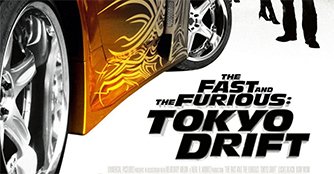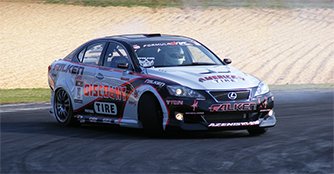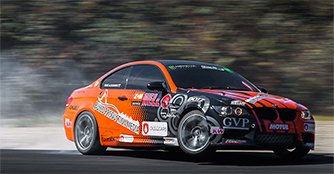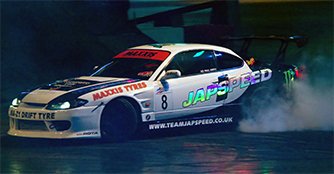A brief introduction to drifting
29 Oct 2007|24,548 views
Fast and Furious: Tokyo Drift showcased what has gripped the motorsports world by its throat. Cars sliding around impossible bends and tight corners, the smell of burnt rubber and smoke coming out thick from the rear wheel are all part of it. Welcome, to the world of drifting.
Drifting and power slides are often mistaken to be the same thing. However, there are differences that you need to know before you declare yourself Drift King of Mount Faber.
In a power slide, the driver will throw his car into a drift, after which he will counter that drift, straighten out and exit that corner. But in drifting, rather than countering the first drift, the driver will throw his car out into another drift, or maintain that drift for as long as possible without spinning out.
So, drifting requires a lot more skill and co-ordination and is a lot more complex than doing just one power slide. In a nutshell, it would be safe to say that drifting is a series of controlled power slides.
How did drifting start?
The foremost creator of drifting techniques would be Kuninitsu Takahashi back in the 70s. He would hit the apex of a turn at high speed, drift through the corner and exit, maintaining the same high speed. He won several championships and a legion of fans, one of whom was Keiichi Tsuchiya.
Tsuchiya soon started practicing his drifting skills on the mountain roads of Japan and gaining street-cred amongst the racing crowd. In 1988, he helped organize one of the first official drift competitions in Japan. The earliest drift competition outside of Japan was held in Willow Springs raceway, California. Since then, drifting has gained massive followers and even had movies made about it, such as Initial D and Fast and Furious: Tokyo Drift.
Drifting Cars and Techniques
Some popular drift cars are the Toyota AE86, Toyota Supra, Nissan Silvia, Nissan Skyline and the Mazda RX-7. These are favoured because they are rear-wheel drive (RWD) cars. RWD cars are easier to throw into a drift because power is sent to the rear wheels, making it is easier to 'slip' the rear wheels
There are different ways to engage your car in a drift., with techniques of varying difficulty. Let's start with the basic and move on to the more difficult ones.
Drifting and power slides are often mistaken to be the same thing. However, there are differences that you need to know before you declare yourself Drift King of Mount Faber.
In a power slide, the driver will throw his car into a drift, after which he will counter that drift, straighten out and exit that corner. But in drifting, rather than countering the first drift, the driver will throw his car out into another drift, or maintain that drift for as long as possible without spinning out.
So, drifting requires a lot more skill and co-ordination and is a lot more complex than doing just one power slide. In a nutshell, it would be safe to say that drifting is a series of controlled power slides.
How did drifting start?
The foremost creator of drifting techniques would be Kuninitsu Takahashi back in the 70s. He would hit the apex of a turn at high speed, drift through the corner and exit, maintaining the same high speed. He won several championships and a legion of fans, one of whom was Keiichi Tsuchiya.
Tsuchiya soon started practicing his drifting skills on the mountain roads of Japan and gaining street-cred amongst the racing crowd. In 1988, he helped organize one of the first official drift competitions in Japan. The earliest drift competition outside of Japan was held in Willow Springs raceway, California. Since then, drifting has gained massive followers and even had movies made about it, such as Initial D and Fast and Furious: Tokyo Drift.
Drifting Cars and Techniques
Some popular drift cars are the Toyota AE86, Toyota Supra, Nissan Silvia, Nissan Skyline and the Mazda RX-7. These are favoured because they are rear-wheel drive (RWD) cars. RWD cars are easier to throw into a drift because power is sent to the rear wheels, making it is easier to 'slip' the rear wheels
There are different ways to engage your car in a drift., with techniques of varying difficulty. Let's start with the basic and move on to the more difficult ones.
Note: These techniques apply to RWD cars unless otherwise stated
Hand-brake Drift - Clutch in, handbrake up then once traction to rear wheels is lost, release clutch, accelerate and counter steer.
Powerslide - Done at corner exit with gas pedal down hard.
Shift Lock - Accelerate, quick downshift, let engine rev hard. Momentary wheel lock will occur.
Clutch Kick - Clutch in and out several times. This is will shock the powertrain and cause an imbalance to the car. Rear wheels will then slip. Apply 'toe-heel' position for control.
Braking Drift - Hard brake into a corner, hard throttle off to exit. Driving wheels will lose traction. Steer accordingly. This method can be applied to front wheel drive cars as well.
Inertia Drift - Turn away from turn and then quickly turn back. This will cause the car's weight to transfer from the inside of the turn to the outside of the turn causing the rear to swing into the desired drift line. Apply handbrake to lock rear wheels.
The techniques mentioned above are just some of the many methods used by today's drifters. To drift your car with these techniques isn't easy. A lot of practice is required for it to be done properly.
Before you get any ideas about being your neighborhood's local drifting hero, be reminded that this article is meant to be informative and not act as your practice guide to drift techniques. Drifting is a sport and as with any sport, there are risks involved. It should only be done on the track and with proper safety precautions.
There you have it, your introduction to drifting. Drifting has certainly been the most exciting thing to happen to motorsports since the introduction of Race Queens, and it is here to stay. You had better start liking the smell of burnt rubber.
*This article was updated on 20th June 2018.
Hand-brake Drift - Clutch in, handbrake up then once traction to rear wheels is lost, release clutch, accelerate and counter steer.
Powerslide - Done at corner exit with gas pedal down hard.
Shift Lock - Accelerate, quick downshift, let engine rev hard. Momentary wheel lock will occur.
Clutch Kick - Clutch in and out several times. This is will shock the powertrain and cause an imbalance to the car. Rear wheels will then slip. Apply 'toe-heel' position for control.
Braking Drift - Hard brake into a corner, hard throttle off to exit. Driving wheels will lose traction. Steer accordingly. This method can be applied to front wheel drive cars as well.
Inertia Drift - Turn away from turn and then quickly turn back. This will cause the car's weight to transfer from the inside of the turn to the outside of the turn causing the rear to swing into the desired drift line. Apply handbrake to lock rear wheels.
The techniques mentioned above are just some of the many methods used by today's drifters. To drift your car with these techniques isn't easy. A lot of practice is required for it to be done properly.
Before you get any ideas about being your neighborhood's local drifting hero, be reminded that this article is meant to be informative and not act as your practice guide to drift techniques. Drifting is a sport and as with any sport, there are risks involved. It should only be done on the track and with proper safety precautions.
There you have it, your introduction to drifting. Drifting has certainly been the most exciting thing to happen to motorsports since the introduction of Race Queens, and it is here to stay. You had better start liking the smell of burnt rubber.
Finding the right performance parts for your car? Click here to check out what is available!
*This article was updated on 20th June 2018.
Fast and Furious: Tokyo Drift showcased what has gripped the motorsports world by its throat. Cars sliding around impossible bends and tight corners, the smell of burnt rubber and smoke coming out thick from the rear wheel are all part of it. Welcome, to the world of drifting.
Drifting and power slides are often mistaken to be the same thing. However, there are differences that you need to know before you declare yourself Drift King of Mount Faber.
In a power slide, the driver will throw his car into a drift, after which he will counter that drift, straighten out and exit that corner. But in drifting, rather than countering the first drift, the driver will throw his car out into another drift, or maintain that drift for as long as possible without spinning out.
So, drifting requires a lot more skill and co-ordination and is a lot more complex than doing just one power slide. In a nutshell, it would be safe to say that drifting is a series of controlled power slides.
How did drifting start?
The foremost creator of drifting techniques would be Kuninitsu Takahashi back in the 70s. He would hit the apex of a turn at high speed, drift through the corner and exit, maintaining the same high speed. He won several championships and a legion of fans, one of whom was Keiichi Tsuchiya.
Tsuchiya soon started practicing his drifting skills on the mountain roads of Japan and gaining street-cred amongst the racing crowd. In 1988, he helped organize one of the first official drift competitions in Japan. The earliest drift competition outside of Japan was held in Willow Springs raceway, California. Since then, drifting has gained massive followers and even had movies made about it, such as Initial D and Fast and Furious: Tokyo Drift.
Drifting Cars and Techniques
Some popular drift cars are the Toyota AE86, Toyota Supra, Nissan Silvia, Nissan Skyline and the Mazda RX-7. These are favoured because they are rear-wheel drive (RWD) cars. RWD cars are easier to throw into a drift because power is sent to the rear wheels, making it is easier to 'slip' the rear wheels
There are different ways to engage your car in a drift., with techniques of varying difficulty. Let's start with the basic and move on to the more difficult ones.
Drifting and power slides are often mistaken to be the same thing. However, there are differences that you need to know before you declare yourself Drift King of Mount Faber.
In a power slide, the driver will throw his car into a drift, after which he will counter that drift, straighten out and exit that corner. But in drifting, rather than countering the first drift, the driver will throw his car out into another drift, or maintain that drift for as long as possible without spinning out.
So, drifting requires a lot more skill and co-ordination and is a lot more complex than doing just one power slide. In a nutshell, it would be safe to say that drifting is a series of controlled power slides.
How did drifting start?
The foremost creator of drifting techniques would be Kuninitsu Takahashi back in the 70s. He would hit the apex of a turn at high speed, drift through the corner and exit, maintaining the same high speed. He won several championships and a legion of fans, one of whom was Keiichi Tsuchiya.
Tsuchiya soon started practicing his drifting skills on the mountain roads of Japan and gaining street-cred amongst the racing crowd. In 1988, he helped organize one of the first official drift competitions in Japan. The earliest drift competition outside of Japan was held in Willow Springs raceway, California. Since then, drifting has gained massive followers and even had movies made about it, such as Initial D and Fast and Furious: Tokyo Drift.
Drifting Cars and Techniques
Some popular drift cars are the Toyota AE86, Toyota Supra, Nissan Silvia, Nissan Skyline and the Mazda RX-7. These are favoured because they are rear-wheel drive (RWD) cars. RWD cars are easier to throw into a drift because power is sent to the rear wheels, making it is easier to 'slip' the rear wheels
There are different ways to engage your car in a drift., with techniques of varying difficulty. Let's start with the basic and move on to the more difficult ones.
Note: These techniques apply to RWD cars unless otherwise stated Hand-brake Drift - Clutch in, handbrake up then once traction to rear wheels is lost, release clutch, accelerate and counter steer.
Powerslide - Done at corner exit with gas pedal down hard.
Shift Lock - Accelerate, quick downshift, let engine rev hard. Momentary wheel lock will occur.
Clutch Kick - Clutch in and out several times. This is will shock the powertrain and cause an imbalance to the car. Rear wheels will then slip. Apply 'toe-heel' position for control.
Braking Drift - Hard brake into a corner, hard throttle off to exit. Driving wheels will lose traction. Steer accordingly. This method can be applied to front wheel drive cars as well.
Inertia Drift - Turn away from turn and then quickly turn back. This will cause the car's weight to transfer from the inside of the turn to the outside of the turn causing the rear to swing into the desired drift line. Apply handbrake to lock rear wheels.
The techniques mentioned above are just some of the many methods used by today's drifters. To drift your car with these techniques isn't easy. A lot of practice is required for it to be done properly.
Before you get any ideas about being your neighborhood's local drifting hero, be reminded that this article is meant to be informative and not act as your practice guide to drift techniques. Drifting is a sport and as with any sport, there are risks involved. It should only be done on the track and with proper safety precautions.
There you have it, your introduction to drifting. Drifting has certainly been the most exciting thing to happen to motorsports since the introduction of Race Queens, and it is here to stay. You had better start liking the smell of burnt rubber.
Powerslide - Done at corner exit with gas pedal down hard.
Shift Lock - Accelerate, quick downshift, let engine rev hard. Momentary wheel lock will occur.
Clutch Kick - Clutch in and out several times. This is will shock the powertrain and cause an imbalance to the car. Rear wheels will then slip. Apply 'toe-heel' position for control.
Braking Drift - Hard brake into a corner, hard throttle off to exit. Driving wheels will lose traction. Steer accordingly. This method can be applied to front wheel drive cars as well.
Inertia Drift - Turn away from turn and then quickly turn back. This will cause the car's weight to transfer from the inside of the turn to the outside of the turn causing the rear to swing into the desired drift line. Apply handbrake to lock rear wheels.
The techniques mentioned above are just some of the many methods used by today's drifters. To drift your car with these techniques isn't easy. A lot of practice is required for it to be done properly.
Before you get any ideas about being your neighborhood's local drifting hero, be reminded that this article is meant to be informative and not act as your practice guide to drift techniques. Drifting is a sport and as with any sport, there are risks involved. It should only be done on the track and with proper safety precautions.
There you have it, your introduction to drifting. Drifting has certainly been the most exciting thing to happen to motorsports since the introduction of Race Queens, and it is here to stay. You had better start liking the smell of burnt rubber.
Finding the right performance parts for your car? Click here to check out what is available!
*This article was updated on 20th June 2018.



























